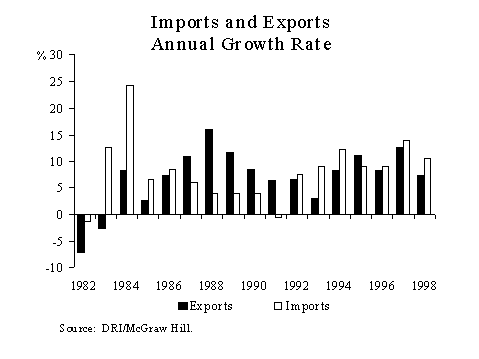
Consumption
Overall consumer spending is predicted to slow, growing by 3.0 percent in 1998, less than the 3.3 percent growth rate of 1997 (see Table 18). Durable goods consumption is expected to grow at 3.7 percent in 1998, down from a robust 5.7 percent in 1997. The slowdown in durable goods consumption should not be interpreted as a lack of consumer confidence in the economy. Consumers have been extremely euphoric about the economy as witnessed by the robust readings of the Consumer Confidence Index, which reached a three-decade high in February. Rather, demand for durable and non-durable goods is expected to soften due to a slowdown in personal income growth.
Investment
The Committee staff is estimating investment growth of 6.4 percent for 1998, following much stronger growth of 11.1 percent in 1997. A cooling-off period in investment is anticipated after double-digit growth rates in the first two quarters of 1997. The anticipated slowdown in investment is attributable to an expected decline in inventories, with retail sales expected to weaken relative to the recent period.
Net Exports
The Committee staff predicts export growth of 7.3 percent for 1998,
following growth of 12.5 percent during 1997 (see Table 18). Import growth
is also expected to slow down in 1998, but by less than exports. Imports
are expected to grow 10.5 percent in 1998, following 13.9 percent growth
in 1997, implying continued deterioration in the U.S. trade balance. As
Figure 14 shows, the current expansion is characterized by robust export
and import growth as compared to the previous expansion, indicative of
the ever-increasing presence of the U.S. in international trade. While
a strong dollar, and the recent collapse of many Southeast Asian currencies,
have made exports to Asia precarious, stronger than previously anticipated
growth in Europe and Canada will sustain U.S. exports. As already mentioned,
the trade gap is set to achieve one more record imbalance reflecting the
appetite for cheap overseas products made cheaper by the appreciating dollar.


Government Spending
Real government spending for 1997 grew by 1.0 percent, with a 1.4 percent decline in federal government spending partially offsetting an increase in spending by state and local governments of 2.4 percent. For 1998, the Committee staff anticipates a 0.3 percent decline in federal government spending, while state and local government spending are expected to grow by 2.1 percent, resulting in 1.2 percent growth for the government sector overall.

Stock prices, as measured by Standard and Poor's Index of 500 common
stock prices, grew by 30.1 percent in 1997, and will be followed by slower
but still robust growth of 18.1 percent for 1998.19
The average value of the S&P 500 index for February 1998 stood at 1,023.4.
Our forecast for all of 1998 is 1,031.0.
19. The stock market is much more volatile than the level
of corporate profits which drives it. Therefore, the Committee staff estimates
stock market growth by comparing annual averages rather than by comparing
the year-end value to the value at the beginning of the year. Any single
day’s value reflects the news and rumors which may happen to be in the
air that day, making it impossible as well as undesirable to forecast.
Annual averages are purged of this daily volatility and are therefore more
reflective of the fundamentals driving the market.

The Committee staff baseline forecast presumes a decline in overall
growth in Asia from 2.6 percent in 1997 to 1.6 percent in 1998.20
However, lower growth than anticipated could affect the Committee staff
forecast through three possible channels. First, a weaker Asia means weaker
demand for U.S. exports by Asian firms and consumers. Second, a weaker
Asian economy threatens the profits of U.S. firms with direct investments
in that part of the world. Finally, additional weakness could either cause
Asian currencies to devaluate further or drive Asian producers to market
their own exports even more aggressively by further lowering prices. This
could lead domestic and foreign consumers to substitute cheaper Asian imports
for goods produced in the U.S.
20. The Committee staff baseline forecast incorporates
data and forecasts for international economic variables made available
by DRI/McGraw-Hill.
In order to test the sensitivity of the Committee staff forecast to unanticipated weakness in Asian, we analyzed the impact of a scenario whereby the baseline assumption of 1.6 percent growth is reduced to zero growth. This reduction reduces U.S. export growth from 7.3 percent to 4.4 percent, and real U.S. GDP growth from 2.6 percent to 2.2 percent. Both employment and consumer price growth fall slightly. If additionally, import prices fall by 5.0 percent, U.S. import growth rises from its 10.5 percent baseline to 11.4 percent. Real GDP growth falls an additional 0.1 percent to 2.1 percent.
The Asian crisis could also affect the Committee staff’s baseline forecast for U.S. corporate profit growth of 5.7 percent. U.S. corporations earn 13 percent of their profits from direct (non-financial) foreign investment. Of this, 16.8 percent is derived from investment in Asia. If return on this investment should fall to zero for 1998, then U.S. corporate profits could fall by $18.3 billion, reducing total profit growth from 5.7 percent to 3.3 percent.
As agreements between the International Monetary Fund, the world banking system, and the Asian countries seem near, the scaffolding for a recovery appears to be falling into place. The possibility that the Asian crisis will have less of an impact than anticipated—producing, for example, stronger than anticipated exports—poses an upside risk to our forecast.
A substantial supply shock from a source other than Asia could also have a significant and long lasting impact on U.S. growth. The precarious nature of the Middle East, particularly the situation in Iraq, could provide cause for concern and instability, directly influencing the price of oil and related products, throwing our inflation forecast off balance. Additional fiscal discipline among prospective single currency European Union member countries could exert an adverse impact on Europe’s medium-term growth potential.